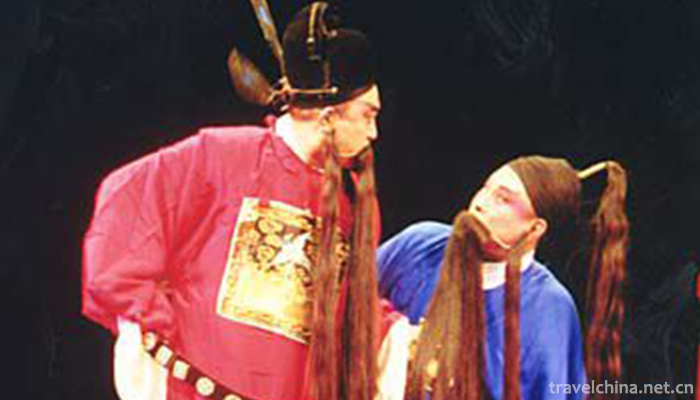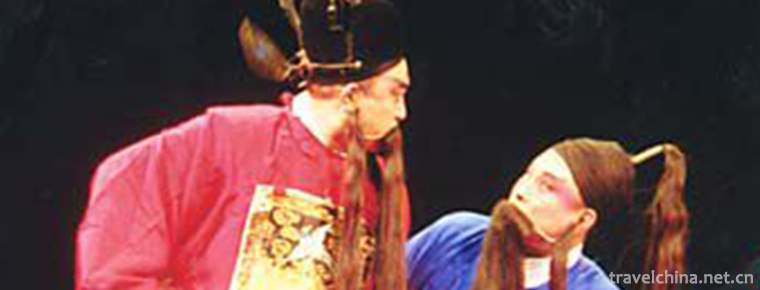Yingge Liushu
Yingge Liushu
Yingge Liushu, also known as Yingge Liuzi, is a traditional art form of rap and singing spread in southwestern Shandong, southern Shandong, Eastern Henan and Northern Jiangsu. Legend has it that the Liuzi opera card "Yinggeliu" originated in the Ming Dynasty evolved, and on this basis, the book of pendants was derived.
On June 7, 2008, the "Yingge Liu Shu" declared by Heze City, Shandong Province, was listed in the second batch of national intangible cultural heritage list with the approval of the State Council.
historical origin
According to records, Yingge Liushu has a history of at least 200 years.
Although Yingge Liushu has a long history, it is not widely circulated. The most influential artist in Southwest Shandong in the past hundred years, and also the earliest known Yinggeliu calligrapher in Heze area, is Zhang Xianzi in Zhongdi Circle of Cao County (1848-1928, lost name). The flourishing period of Yingge Liushu is the active era of Zhang Xianzi. Zhang's heir was Zhang Baoliang of Benzhuang, and the next generation was Zheng Yukun of Zhengzhuang, Cao Zhitian of Dingtao (1904-1976). Zheng Yukun passed Yingge Liushu's skill to Gao Zhijun of Heze in his later years, and now this rare song is only his heir.
Representative Program
Yingge Liushu's main programs are "stealing poetry", "miao Chang yinzi", "roll foil", "rabbit kidnap pawn ticket" and other sixty sections; Longfeng bracelet","sweater story","Yang Zongying down the mountain"more than ten long books.
Singing Form
Yingge Liushu sings white and white, which is a singing style used repeatedly. The singing form also has three strings. The basic aria is four sentences, and the rest are deepened accordingly. And after the four sentences, there must be a tail-lapping liner "where, ah, ah, ah, hm".
The singing form of Yingge Liushu is relatively simple, mostly in the double-file of playing and singing. Yinggeliu's catalogues are very rich, some of them are elegant and difficult to understand, the other part is easy to understand, fresh and simple, showing the diversity of the source of the catalogue. Its aria music is rich and colorful in the early stage, but simple and rigid in the later stage. It is closely related to Liuzi Opera and local operas, and has a variety of research values. It directly promotes the book of pendants, and has an important influence on its music, repertoire, performance form and style.
Inheritance Significance
Yingge Liushu is closely related to Liuzi Opera and local Xiaoqu, and has many research values. It directly promotes the book of pendants, and has an important influence on its music, repertoire, performance form and style.
Yingge Liushu is one of the rare traditional operas in northern Chinese opera. It had a great influence in the border area of Shandong, Henan and Anhui in the middle and late Qing Dynasty. But in the early years of the Republic of China, the rapid shrinkage, Henan and Anhui Branches have been basically silent, only Heze left a claw of mud, known as "living fossils".


-
1.Tianjin Panshan Scenic Area
Tianjin Panshan Scenic Area, located 15 kilometers northwest of Jixian County, Tianjin City, covers an area of 106 square kilometers
Time 2018-11-24 -
2.Luxi County Alu Ancient Cave Scenic Area
The Alu Gudong Scenic Area is located in southeastern Yunnan Province, 2 kilometers west of Luxi County Town, Honghe Prefecture, Yunnan Province. "Alu ancient cave" is a Yi language,
Time 2019-02-06 -
3.Tianjin Binhai Carrier Theme Park
Tianjin Binhai Aircraft Carrier Theme Park (hereinafter referred to as "Binhai Aircraft Carrier") is located in Hangu Bagua Beach, Binhai New Area, Tianjin City
Time 2019-02-21 -
4.Daur Ruzhigle Dance
"Luzhigle" is a representative folk dance of Daur nationality. It varies from place to place, including "Alhambo", "Langtudabe", "Hakumai", "Hagen Melger&q
Time 2019-04-22 -
5.Ewenki Folk Songs
Ewenki folk songs are beautiful and beautiful, with unique style. People are improvised and sing improvised lyrics. Pastoral songs and hunting songs show the brave and simple
Time 2019-04-28 -
6.Kazakh Karakol Leha
On May 23, 2011, Kazakh Karakol Kazakh was listed in the third batch of national intangible cultural heritage list with the approval of the State Council.
Time 2019-05-02 -
7.Xibo Folk Stories
Xibo folk tales, Xibo people are descendants of Xianbei people in ancient times. Xianbei was originally nomadic in the eastern foot of the Great Hinggan Mountains, and has been hunting and fishing for
Time 2019-07-01 -
8.Da Yu
Yu, surnamed Si, is famous for his life. (Yu Yu is the name). History is called Da Yu and Emperor Yu. Xia Hou Shi Chieftain Xia Dynasty The founding king. Yu is Yellow Emperor Great grandson, Zhuan Gr
Time 2019-09-07 -
9.Deyang cultural undertakings
As of the end of 2018, Deyang City has 7 public libraries with a total collection of 1189.8 thousand books (pieces). The city has 7 cultural centers, 127 cultural stations, 10 museums, 48 art performing groups, and 27 theaters and cinemas. By the end of the year,
Time 2020-12-14 -
10.Land resources in Suining
The total cultivated land area of Suining is 2.2815 million mu, of which the purple soil area is the largest, accounting for 62% of the cultivated land area, which is widely distributed in the low mountain and hilly areas.
Time 2020-12-16 -
11.Neijiang economy
In 2019, the GDP of Neijiang City will reach 143.33 billion yuan, an increase of 7.8% over the previous year in terms of comparable prices. Among them, the added value of the primary industry was 24.050 billion yuan, an increase of 2.9%; the added value
Time 2020-12-16 -
12.Nanchong hydrology
Nanchong is rich in precipitation. The average annual precipitation is 1000 mm, excluding evaporation, the annual total water is about 4.191 billion cubic meters, and the average annual runoff depth is about 313 mm. The distribution of runoff depth is generally
Time 2020-12-17